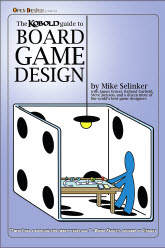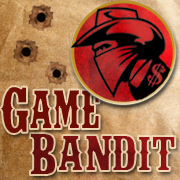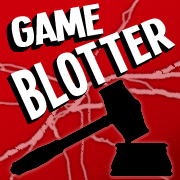Welcome to Purple Pawn, covering games played around the world by billions of people every day.
The Kobold Guide to Board Game Design
16 Sep
Posted by Yehuda Berlinger as Card Games, Modern Board Games
 The Kobold Guide to Board Game Design is a 140 page eBook from Kobold Quarterly. The books contains various articles from the likes of James Ernest, Richard Garfield, Steve Jackson, Dale Yu, and others. It costs $20 print/$10 PDF, but I received a free PDF review copy.
The Kobold Guide to Board Game Design is a 140 page eBook from Kobold Quarterly. The books contains various articles from the likes of James Ernest, Richard Garfield, Steve Jackson, Dale Yu, and others. It costs $20 print/$10 PDF, but I received a free PDF review copy.
The articles are not academic and do not cite sources or present any actual data; as such, the book is simply a collection of thoughts on various design topics and advice from some experienced designers. The information appears to be sound and the topics are interesting if you’re interested in the subject of designing a hobby game. I read through a few of the articles and skimmed some of the others; I don’t think the information will do you much good if you’re looking to design and publish the “next Monopoly”. It appears to be intended to help you produce a game that is fun for gamers.
Speaking of Monopoly, it’s funny how often Monopoly is mentioned in this book, a book that is aimed squarely at the hobby market. Sometimes to give it props (“Complain all you want about the mechanics of Monopoly. That game works.” – James Ernest) and sometimes to diss it (“Chalk up another failure for Monopoly on this one; “the rich get richer” might be realistic, but it’s not much fun.” – Dave Howell).
2 Comments
Sorry, the comment form is closed at this time.
Trending
- Massdrop.com
- Oh the Irony—Illuminati Card Game Continues to Inspire Conspiracy Theorists
- Footprints, an Educational Ecology Game
- USPS Adds Board Game Flat Rate Box
- Home
- Baila, the Estonian Drinking Card Game
- Crystal Caste Wins Dice Patent Suit Against Hasbro
- Mirror Game, Red and Blue
- Hasbro and Mattel Merger?
- Are Board Games Dangerous?
Archives
Most Popular Articles
- Oh the Irony—Illuminati Card Game Continues to Inspire Conspiracy Theorists
- The 20 Most Valuable Vintage Board Games
- The Truth About Dominoes On Sunday in Alabama
- Sequence Game, and Variants
- USPS Adds Board Game Flat Rate Box
- Baila, the Estonian Drinking Card Game
- The 13 Most Popular Dice Games
- Are Board Games Dangerous?
- Guess Who? The Naked Version
- What Happened to the Jewel Royale Chess Set?
Recent Posts
- Toy Fair 2019—Breaking Games
- Talisman Kingdom Hearts Edition
- Toy Fair 2019—Winning Moves
- Toy Fair 2019—Games Workshop
- Toy Fair 2019—Star Wars Lightsaber Academy
- Toy Fair 2019—Stranger Things Games
- Toy Fair 2019—HABA
- Licensing Roundup
- Game Bandit
- 2018 A Difficult Year For Hasbro But Not For D&D Or MtG
Recent Comments
- on Toy Fair 2019—Winning Moves
- on Game Bandit
- on Second Look—Dungeons & Dragons Waterdeep Dragon Heist
- on Crowdfunding Highlights
- on Beyblade SlingShock
- on Game Bandit
- on Game Bandit
- on Watch This Game!, the Board Game Review Board Game
- on Second Look—Vampire: The Masquerade 5th Edition
- on Palladium Books Loses Robotech IP License, Cancels Five-Year-Overdue Robotech RPG Tactics Kickstarter





Is Monopoly to board game designers what D&D is to RPG designers? The 800lbs silverback gorilla of the field – Venerable, often updated, occasionally maligned, and a common reference point for new design.
Daniel,
I would say no, because D&D is considered “good” by the people in the hobby, whereas Monopoly isn’t. Settlers is the gorilla at the moment, I guess.
RPG is pretty much hobby gamer all the way through. No one “casually” plays an RPG. Board games are divided into different camps: mainstream, hobby, and specialty, aka those who use the game to increase the fun of whatever they’re doing, those who play the game to enjoy the game, and those who play the game to achieve a purpose (learn, discuss, practice). Video games are divided too, into hobby and casual gamer markets.
While people like me try to lump them together, as do the people who write articles on “game design”, as if one could boil all game designs into universal principles, I suspect that there is not always lot of overlap.
Yehuda